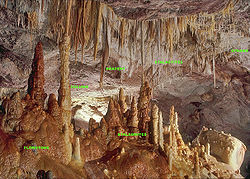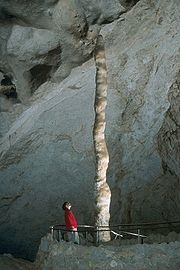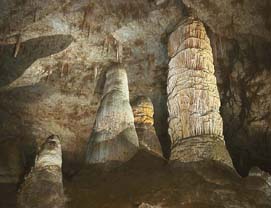
Stalagmite
Encyclopedia


Greek language
Greek is an independent branch of the Indo-European family of languages. Native to the southern Balkans, it has the longest documented history of any Indo-European language, spanning 34 centuries of written records. Its writing system has been the Greek alphabet for the majority of its history;...
σταλαγμίτης - stalagmitês, from σταλαγμίας - stalagmias, "dropping, trickling") is a type of speleothem
Speleothem
A speleothem , commonly known as a cave formation, is a secondary mineral deposit formed in a cave. Speleothems are typically formed in limestone or dolostone solutional caves.-Origin and composition:...
that rises from the floor
Floor
A floor is the walking surface of a room or vehicle. Floors vary from simple dirt in a cave to many-layered surfaces using modern technology...
of a limestone
Limestone
Limestone is a sedimentary rock composed largely of the minerals calcite and aragonite, which are different crystal forms of calcium carbonate . Many limestones are composed from skeletal fragments of marine organisms such as coral or foraminifera....
cave
Cave
A cave or cavern is a natural underground space large enough for a human to enter. The term applies to natural cavities some part of which is in total darkness. The word cave also includes smaller spaces like rock shelters, sea caves, and grottos.Speleology is the science of exploration and study...
due to the dripping of mineralized solution
Solution
In chemistry, a solution is a homogeneous mixture composed of only one phase. In such a mixture, a solute is dissolved in another substance, known as a solvent. The solvent does the dissolving.- Types of solutions :...
s and the deposition of calcium carbonate
Calcium carbonate
Calcium carbonate is a chemical compound with the formula CaCO3. It is a common substance found in rocks in all parts of the world, and is the main component of shells of marine organisms, snails, coal balls, pearls, and eggshells. Calcium carbonate is the active ingredient in agricultural lime,...
. This stalagmite formation occurs only under certain pH conditions within the underground cavern. The corresponding formation on the ceiling of a cave is known as a stalactite
Stalactite
A stalactite , "to drip", and meaning "that which drips") is a type of speleothem that hangs from the ceiling of limestone caves. It is a type of dripstone...
. If these formations grow together, the result is known as a column.

Skin
-Dermis:The dermis is the layer of skin beneath the epidermis that consists of connective tissue and cushions the body from stress and strain. The dermis is tightly connected to the epidermis by a basement membrane. It also harbors many Mechanoreceptors that provide the sense of touch and heat...
oils can alter the surface where the mineral water will cling, thus affecting the growth of the formation. Oils and dirt from human contact can also stain the formation and change its color permanently.
Similar structures can also form in lava tubes, associated with some types of lavacicles, although the mechanism of formation is very different. Stalactites and stalagmites can also form on concrete
Concrete
Concrete is a composite construction material, composed of cement and other cementitious materials such as fly ash and slag cement, aggregate , water and chemical admixtures.The word concrete comes from the Latin word...
ceilings and floors, although they form much more rapidly there than in the natural cave environment.
The largest stalagmite in the world is 62.2 metres (204.1 ft) high and is located in the cave of Cueva Martin Infierno, Cuba.
In the Zagros Mountains
Zagros Mountains
The Zagros Mountains are the largest mountain range in Iran and Iraq. With a total length of 1,500 km , from northwestern Iran, and roughly correlating with Iran's western border, the Zagros range spans the whole length of the western and southwestern Iranian plateau and ends at the Strait of...
of south Iran, approximately 6 kilometres (3.7 mi) from the ancient city of Bishapur
Bishapur
thumb|Irano-Roman floor mosaic detail from the palace of [[Shapur I]] at BishapurBishapur is an ancient city situated south of modern Faliyan, Iran on the ancient road between Persis and Elam. The road linked the Sassanid capitals Istakhr and Ctesiphon...
, in the Shapur cave
Shapur cave
Shapur cave is located in the Zagros Mountains, in southern Iran, about 6 km from the ancient city of Bishapur. This cave is near Kazerun....
on the fourth of five terraces stands the 3rd century CE statue of Shapur I
Shapur I
Shapur I or also known as Shapur I the Great was the second Sassanid King of the Second Persian Empire. The dates of his reign are commonly given as 240/42 - 270/72, but it is likely that he also reigned as co-regent prior to his father's death in 242 .-Early years:Shapur was the son of Ardashir I...
, second ruler of the Sassanid Empire
Sassanid Empire
The Sassanid Empire , known to its inhabitants as Ērānshahr and Ērān in Middle Persian and resulting in the New Persian terms Iranshahr and Iran , was the last pre-Islamic Persian Empire, ruled by the Sasanian Dynasty from 224 to 651...
. The statue, carved from one stalagmite, is nearly 7 m (23 ft) high.

